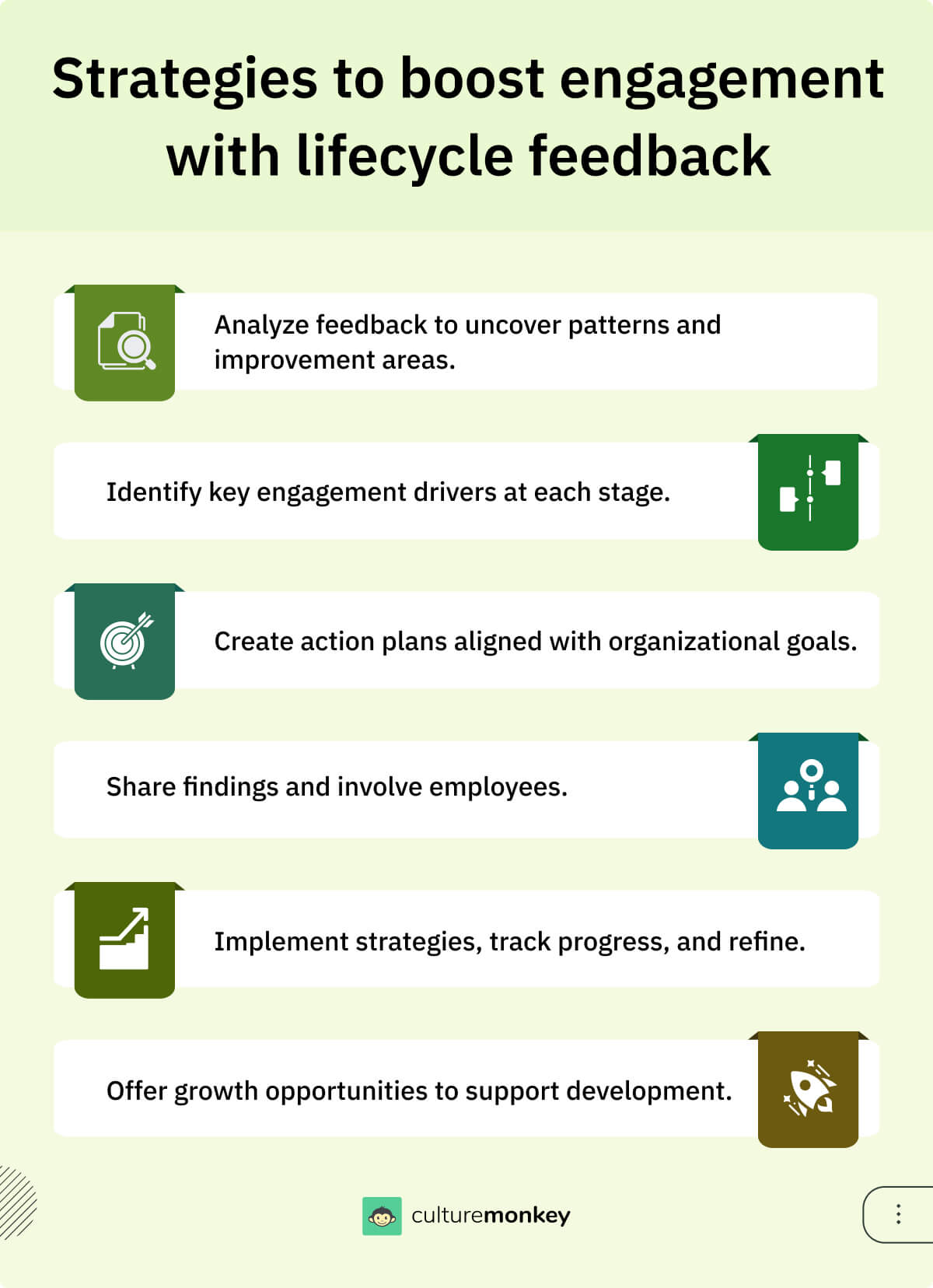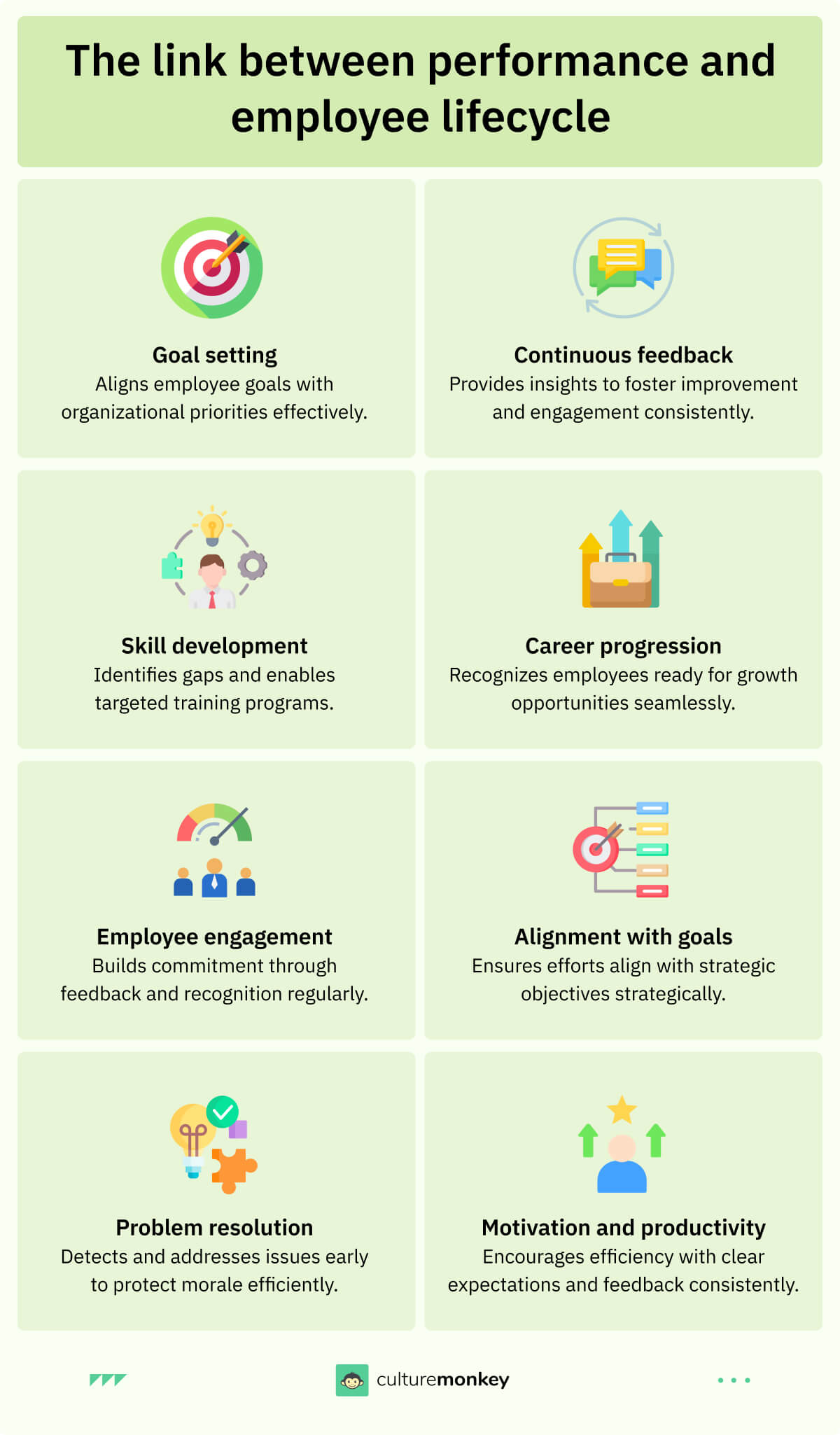7 Employee life cycle stages and how they align people with business goals in 2025

Think back to the first time you assembled your very own bicycle. The excitement was real — shiny new wheels, a fresh adventure just waiting to begin. You eagerly pieced it together, dreaming of racing down the street.
But without tightening every bolt properly or checking the brakes, the ride could turn wobbly or even dangerous pretty quickly. It wasn’t just about owning the bike; it was about making sure every part worked together seamlessly for a safe, thrilling journey.
The employee experience lifecycle operates much the same way. It's not enough to simply recruit great talent or celebrate milestones at the end. Every stage from brand attraction and onboarding to development, engagement, and even exit requires intentional planning and care.
When each phase is thoughtfully managed, the entire employee journey becomes smoother, more rewarding, and built to last, much like that perfectly assembled bike you never wanted to get off.
Blog Highlights


What is the employee lifecycle?

The employee lifecycle is the complete journey an employee experiences with an organization, spanning from initial recruitment to their eventual departure. It captures the different phases an employee moves through, including attraction, hiring, development, engagement, retention, and exit, shaping the foundation of talent lifecycle management. Understanding employee life cycle allows organizations to maximize satisfaction, productivity, and loyalty.
From the first interaction during the recruitment process to nurturing growth through the onboarding life cycle and professional development programs, every stage influences an employee’s perception of the company.
Organizations that actively manage the engagement lifecycle build deeper connections with individual employees, ensuring that individuals feel valued and supported at every turn. When the entire employee lifecycle is thoughtfully designed and consistently optimized, it leads to stronger team morale, lower turnover rates, and a more resilient organizational culture.
Mastering the employee lifecycle also empowers businesses to align workforce strategies with broader goals, ensuring that talent is not just managed, but genuinely engaged, developed, and retained for long-term success.
What is employee life cycle management?
Employee lifecycle management refers to the comprehensive process of overseeing and optimizing every stage of an employee’s tenure within a company, from recruitment to retirement. At its core, employee lifecycle management ensures that the organization delivers a consistent, engaging, and rewarding experience across the entire employee experience lifecycle. It involves designing touchpoints and interventions that align with the organization's goals.
A strong employee lifecycle model addresses critical areas like onboarding, performance management, development, retention, and offboarding, creating a continuous cycle of improvement for both the employee and the employer. Effective management of the employee engagement life cycle is about more than just administrative tasks; it focuses on crafting meaningful experiences that foster loyalty, productivity, and advocacy.
By strategically managing each phase, companies not only enhance employee satisfaction but also strengthen their organizational culture and drive better business outcomes. Ultimately, employee lifecycle management transforms the workplace into a space where talent thrives, innovation is nurtured, and organizational success is sustainable.
Why is designing an employee lifecycle strategy important?
A well-crafted employee lifecycle strategy is the foundation for building a motivated, productive, and loyal workforce. It ensures that organizations deliver meaningful experiences to employees across every phase of their journey.
- Enhances employee engagement from the start: An intentional strategy ensures new hires are welcomed, trained, and connected to the organization's mission early. Strong early experiences create a foundation for long-term engagement and retention.
- Improves consistency across employee touchpoints: Without a structured approach, employee experiences can vary wildly between teams or departments. A clear lifecycle strategy ensures every employee, regardless of role or location, receives a consistent and positive experience.
- Identifies opportunities for continuous development: A lifecycle strategy builds in opportunities for ongoing learning, growth, and career advancement. Employees who see a future within the organization are more likely to stay, perform, and advocate for the company.
- Strengthens talent retention and reduces turnover: When employees feel valued at each stage of their journey, they are more inclined to stay longer. A thoughtful strategy addresses key retention drivers like recognition, well-being, and career progression.
- Supports organizational goals and culture alignment: A lifecycle approach ensures employees' roles and growth align with the organization's broader mission. This alignment boosts both individual fulfillment and collective business success.
The 7 employee life cycle stages that have a larger impact on employee engagement

The 7 stages of employee life cycle consists of the key phases an employee navigates during their relationship with an organization. Mastering each of these stages is essential for building a strong employee experience strategy that promotes satisfaction, engagement, and strong employee employer relationship.
1. Brand attraction and awareness
In the attraction stage before candidates even apply, they form impressions about a company's culture, values, and reputation. A strong employer brand attracts high-quality talent who align with organizational goals. This sets the tone for a positive experience from the very start.
Investing in authentic employer branding initiatives can significantly boost your ability to attract top-tier candidates. Every communication, social post, or public review contributes to shaping candidate perceptions.
2. Strategic recruitment and selection
Recruitment is more than filling vacancies; it’s about finding potential candidates who will thrive long-term. A thoughtful recruitment process ensures alignment with both job requirements and company culture. Selecting the right people reduces early attrition and boosts future engagement.
Leveraging data-driven hiring practices can help ensure better role fit and cultural alignment. Effective recruitment strategies ultimately save time, reduce costs, and elevate employee satisfaction from day one.
3. Personalized onboarding experience
A robust onboarding program helps new hires adapt quickly, integrating them into teams and workflows seamlessly. Beyond administrative tasks, great onboarding fosters connection, clarity, and early confidence. It lays the foundation for an engaged and productive workforce journey.
Organizations that invest in structured onboarding see higher retention rates and faster productivity ramps. Personalized welcome experiences leave a lasting positive impression on new employees.
4. Continuous learning and development
Career advancement opportunities are essential to maintain employee motivation and performance. Structured learning programs and skill-building initiatives enhance capability and satisfaction. Development efforts also show a clear investment in employees’ futures.
Promoting a culture of continuous learning keeps employees agile and future-ready. Tailored development plans also signal that the company values long-term career growth.
5. Proactive retention strategies
Retention is driven by a mix of career progression, recognition, and meaningful work. Companies that prioritize employee feedback and well-being naturally strengthen loyalty. A strong employee experience strategy consistently evolves to meet changing workforce needs.
Retention efforts should be tailored based on real-time employee sentiment and life stages. Small gestures of appreciation, flexibility, and recognition can have an outsized impact on loyalty.
6. Thoughtful exit process
An organized and respectful exit process ensures departing employees leave as advocates, not detractors. Exit interviews offer critical feedback for improving the lifecycle experience. Positive exits protect the employer brand and future talent pipelines.
Departing employees often influence external brand perception through reviews and referrals. A dignified exit process leaves doors open for future collaborations or rehiring opportunities.
7. Building advocacy and alumni relations
Employees who leave on good terms often become brand ambassadors or even return as boomerang hires. Maintaining alumni networks preserves relationships and extends the impact of the original employment journey. Advocacy supports both recruitment and cultural strength.
Creating alumni programs or communities strengthens your employer brand visibility externally. Happy alumni can organically promote your culture to future talent pools and business partners.

Navigate the Employee Lifecycle with Clarity
Build a stronger workforce by optimising each step of the employee lifecycle with proven strategies.
What is an employee life cycle survey?

An employee life cycle survey is a systematic process that involves gathering honest feedback from employees at different stages of their employment journey within an organization. It aims to assess their experiences, perceptions, and engagement levels throughout various phases, from the onboarding to the retention stage through to the exit. The survey typically consists of a series of questions designed to capture insights into different aspects of the retention stage of the prospective employee's life cycle.
The purpose of an employee life cycle survey is to gather data and feedback that can help organizations understand and improve the employee experience at each stage.
By collecting information on employee satisfaction, engagement, motivation, and challenges faced during different milestones, employers can identify areas of strength and areas that require attention.
By conducting an employee life cycle survey, organizations can identify trends, strengths, and areas for improvement at each stage of the employee journey. This data can guide strategic decision-making, policy development, and initiatives to enhance employee satisfaction, engagement, and retention.
It allows organizations to make informed changes that positively impact the overall employee experience and ultimately contribute to a healthier and more productive work environment.
How do you measure the employee life cycle?

Measuring the employee life cycle involves the systematic evaluation of various stages and aspects of an employee's journey within an organization.
Here are some common methods and metrics used to measure different phases of the employee life cycle:
Recruitment and onboarding
Metrics in the recruitment stage may include the time-to-fill positions, cost per hire, applicant satisfaction surveys, and onboarding effectiveness ratings.
Additionally, tracking the retention of new hires within their first year can provide insights into the success of the recruitment process and onboarding process for all your employees.
Development and training
Measuring employee development and training involves assessing metrics such as the participation rate in training programs, training hours per employee, skill development assessments, and feedback on the relevance and effectiveness of training initiatives. Promotion rates and internal mobility can also reflect the success of development efforts.
Performance and feedback
Key metrics in this phase include performance ratings, goal achievement rates, frequency and quality of feedback exchanges between managers and employees, and the implementation of performance improvement plans.
Employee satisfaction with the performance management process can be gauged through surveys or feedback sessions.
Employee engagement and satisfaction
Employee engagement surveys are commonly used to measure overall job satisfaction, alignment with organizational values, and employee loyalty.
Metrics such as engagement scores, employee turnover rates, absenteeism, and employee net promoter scores (eNPS) provide insights into employee satisfaction and commitment.
Well-being and work-life balance
Measuring employee well-being involves collecting data on factors like stress levels, work-life balance satisfaction, health and safety incidents, and utilization of wellness programs.
Employee assistance program (EAP) utilization rates, absenteeism due to health issues or personal reasons, and employee self-reported well-being assessments can provide valuable information encouraging managers.
Exit and offboarding
Exit interviews or surveys can help gather feedback on the reasons for employee departures, overall employee experience, and suggestions for improvement.
Tracking turnover rates, exit interview participation rates, and the time it takes to complete the company's offboarding process, and hiring process can offer insights into the effectiveness of the exit interview and recruitment final stage itself.
To measure the employee life cycle effectively, organizations can leverage a combination of quantitative data, such as metrics and surveys, and qualitative data, such as focus groups or interviews.
Regularly collecting and analyzing data at each stage allows organizations to identify trends, areas for improvement, and potential interventions to enhance the employee experience and overall organizational performance.
Importance of measuring engagement throughout employee lifecycle stages

Measuring engagement throughout employee lifecycle stages is crucial for several reasons. Here are the key importance of measuring engagement at each stage:
Early identification of issues
By measuring engagement from the early stages of the employee lifecycle, such as recruitment and onboarding, organizations can quickly identify any potential issues or challenges that may hinder the engagement and satisfaction of new hires.
Early detection allows for timely intervention and corrective measures to be implemented, improving the overall employee experience and reducing the risk of disengagement.
Tailoring interventions
Measuring engagement throughout the lifecycle provides valuable data that helps organizations tailor interventions and initiatives to address specific needs at each stage. Different stages of the employee lifecycle present unique challenges and requirements.
By understanding engagement levels and drivers at each stage, organizations can customize their strategies, programs, and support mechanisms to effectively meet employee expectations and enhance engagement.
Retention and talent management
Engaged employees are more likely to stay with an organization and contribute to its success. Measuring engagement at various lifecycle stages helps organizations identify factors that contribute to higher retention rates.
It enables them to develop targeted retention strategies, such as improving onboarding processes, offering development opportunities, or addressing work-life balance concerns. By nurturing engagement throughout the employee lifecycle, organizations can enhance talent retention and reduce turnover.
Performance and productivity
Engaged employees are generally more motivated, productive, and committed to achieving organizational goals. Measuring engagement at different stages allows organizations to assess its impact on performance and productivity.
By correlating engagement levels with performance metrics, organizations can identify the positive relationship between engagement and outcomes. This information can guide efforts to create a work environment that fosters engagement and maximizes individual and whole team member performance.
Continuous improvement
Measuring engagement throughout the employee lifecycle supports a culture of continuous improvement. By regularly collecting data on engagement, organizations can identify trends, areas for enhancement, and potential obstacles that may impact employee satisfaction and commitment.
This feedback loop allows for targeted interventions and adjustments to policies, practices, and programs to continually enhance engagement and the overall employee experience.
Organizational reputation
Engaged employees can positively influence an organization's reputation as an employer. Measuring engagement throughout the employee lifecycle helps organizations identify areas where they excel in creating a positive work environment.
This information can be used for employer branding and talent acquisition efforts, showcasing the organization as an attractive and supportive place to work. A strong employer brand reputation can enhance the employer brand's ability to attract and retain top talent.
Leadership effectiveness
Measuring engagement throughout the employee lifecycle can provide insights into leadership effectiveness at various stages. By assessing engagement levels and gathering employee feedback on leadership practices, organizations can identify strengths and areas for improvement in their management teams.
Effective leadership is crucial for fostering engagement and driving performance. Data from engagement measurements can help tailor leadership development programs and ensure leaders are equipped to inspire and motivate their teams.
Alignment with organizational goals
By measuring engagement at different stages, organizations can ensure that employees' individual goals and values align with the organization's mission and objectives. Understanding this alignment can help in crafting employee lifecycle strategy, development plans, and initiatives that reinforce the organizational culture.
This alignment is essential for maintaining a cohesive and motivated workforce that works towards common goals, thereby enhancing overall organizational performance and success.
Employee advocacy
Engaged employees are more likely to become advocates for the organization, promoting its values and mission both internally and externally. Measuring engagement throughout the lifecycle helps identify employees who are strong advocates and those who may need more support.
Organizations can leverage this information to build and strengthen their employee advocacy programs, encouraging employees to share positive experiences and contribute to a strong employer brand. This advocacy can attract new talent and enhance the organization's reputation in the market.
Building a lifecycle framework for remote and hybrid teams
Remote and hybrid work models have redefined how organizations approach the employment life cycle. Building a strong lifecycle framework for dispersed teams requires intentional design and thoughtful execution across every stage of the life cycle of an employee.
- Recruitment: Adapt job descriptions and interviews to assess remote collaboration skills and self-motivation. Use virtual hiring platforms that offer realistic job previews to avoid mismatches early in the employee lifecycle journey. Hiring for culture-fit and digital fluency becomes as important as technical qualifications.
- Onboarding: Create a structured digital onboarding plan with interactive sessions, virtual mentorships, and clear resource access. Personalize onboarding schedules to match each new hire’s remote work setup and timezone challenges. Early emotional connection is critical to prevent isolation and accelerate integration into the life cycle of employee in an organization.
- Training and development: Implement asynchronous learning modules combined with scheduled live workshops to support diverse learning styles. Track progress through digital learning management systems aligned with broader employee life cycle management goals. Encourage peer-to-peer learning to foster community in remote settings.
- Performance management: Set clear, measurable KPIs instead of focusing on "visibility" or online hours. Use regular one-on-one video check-ins to deliver real-time feedback and calibrate goals. Transparency in expectations and results is crucial for remote trust-building.
- Engagement and culture building: Organize meaningful virtual engagement activities that go beyond trivia games — think peer-recognition programs or skill-sharing events. Survey employees frequently to understand evolving needs in their remote work experiences. Purposeful culture reinforcement anchors employees throughout the employee lifecycle journey.
- Career growth and mobility: Establish remote-friendly promotion paths by offering clear visibility into internal job postings and leadership development programs. Mentor programs must pair senior leaders with remote talent to break location bias. Visibility in career opportunities fuels retention across the employment life cycle.
- Exit and alumni relations: Conduct detailed virtual exit interviews to capture candid feedback about the remote experience. Maintain remote alumni networks to foster referrals and future rehires. Positive offboarding ensures the full circle of the life cycle of an employee is closed with dignity and potential continuity.
The role of onboarding and offboarding in closing the employee lifecycle loop
Onboarding and offboarding are critical touchpoints in the employee lifecycle, seamlessly connecting the beginning and end of an employee’s journey within an organization.
Effective onboarding sets the foundation for a positive experience, equipping new hires with the knowledge, tools, and support needed to integrate into their roles and the company culture. This stage boosts early engagement, productivity, and long-term retention.
Offboarding, on the other hand, ensures a smooth and respectful transition when employees leave. Conducting exit interviews, managing knowledge transfer, and maintaining positive relationships through alumni programs help organizations gather valuable insights and preserve their reputation.
Together, onboarding and offboarding close the employee lifecycle loop, creating a continuous feedback cycle that enhances employee engagement, strengthens organizational processes, and fosters a culture of improvement and mutual respect.
How to optimize employee engagement based on employee life cycle feedback?

Optimizing employee engagement based on employee life cycle feedback involves leveraging the insights gathered from feedback at each stage of the employee journey to drive meaningful improvements. Here are some steps to effectively optimize the employee life cycle model and engagement:
Analyze feedback data
Start by thoroughly analyzing the feedback data collected throughout the prospective employee or potential employee's life cycle. Identify common themes, trends, and areas for improvement that emerge from the feedback at each stage. Look for patterns and insights that can inform targeted actions to enhance engagement.
Identify engagement drivers
Determine the key factors that positively impact engagement at different stages of the employee life cycle. This can be done by correlating feedback data with engagement levels and performance metrics. Identify the drivers that consistently contribute to higher engagement and prioritize them for further focus and action.
Develop action plans
Based on the analysis and identification of engagement drivers, develop tailored action plans for each stage of the employee life cycle. Consider specific initiatives, policies, and programs that address the identified areas for improvement and capitalize on the engagement drivers. Ensure the action plans are aligned with the organization's values, culture, and strategic goals.
Communicate and involve employees
Transparently communicate the feedback findings and the planned actions to employees. Engage them in the process by seeking their input, suggestions, and participation.
This involvement empowers employees, fosters a sense of ownership, and demonstrates that their honest feedback that is valued and acted upon. Communication channels can include team meetings, employee surveys, focus groups, or dedicated feedback sessions.



Businesses often forget about the culture, and ultimately, they suffer for it because you can’t deliver good service from unhappy employees.
CEO
Zappos
Implement and monitor progress
Implement the action plans and initiatives across the employee life cycle stages. Monitor and track the progress regularly to assess the effectiveness of the implemented strategies.
Continuously measure employee engagement levels and collect feedback to evaluate the impact of the interventions. Adjust the action plans as needed based on ongoing feedback and results.
Provide development opportunities
Offer development opportunities that align with employees' needs and aspirations at different stages of their career progression. This can include training programs, mentorship initiatives, career planning support, and stretch assignments.
Providing avenues for growth and advancement fosters engagement and demonstrates a commitment to employees' professional development.
Foster a positive work environment
Create a positive work environment that supports employee well-being, work-life balance, and collaboration. Encourage open communication, recognition, and a culture of appreciation.
Empower employees to voice their opinions, contribute ideas, and participate in decision-making processes. A supportive work environment promotes engagement and fosters a sense of belonging.
Continuously seek feedback
Maintain a continuous feedback loop by regularly collecting employee feedback at each stage of the employee life cycle. This enables ongoing assessment, adjustment, and improvement.
Use a combination of surveys, focus groups, pulse checks, and one-on-one conversations to gather feedback and ensure it remains an integral part of the engagement optimization process.
By systematically analyzing feedback, identifying drivers, developing action plans, involving employees, monitoring progress, providing development opportunities, fostering a positive work environment, and continuously seeking feedback, organizations can optimize employee engagement throughout the employee life cycle.
This holistic approach enhances the overall employee experience, satisfaction, and commitment, leading to improved productivity, retention, and organizational success.
What phase of the employee lifecycle is used to measure turnover rate?

The phase of the employee lifecycle most commonly used to measure turnover rate is the transition or separation phase. This phase encompasses the various scenarios in which employees leave the organization, such as resignations, retirements, terminations, or transfers. By focusing on this phase, organizations can accurately capture and analyze the data related to employee departures.
Measuring turnover rate during the transition or separation phase is essential because it directly reflects the end point of an employee's journey within the organization. This phase provides clear and definitive data points for when employees exit, allowing organizations to calculate turnover rates effectively.
Understanding turnover rates in the transition or separation phase also helps organizations to evaluate the effectiveness of their employee lifecycle management practices. By correlating turnover data with information from earlier phases such as onboarding, development, and engagement, organizations can pinpoint specific areas that may need improvement.
For instance, high turnover shortly after onboarding might indicate issues with the hiring process or initial training. Conversely, turnover after several years might highlight the need for better career progression opportunities. Thus, measuring turnover in this phase is vital for developing targeted strategies to enhance overall employee retention.
How does performance management contribute to the employee lifecycle?

Throughout the employee lifecycle, from recruitment to separation, effective performance management contributes significantly to the overall success of both individuals and the organization as a whole.
Let's delve into how performance management influences various stages of the employee lifecycle.
- Goal setting: Performance management establishes clear objectives for employees, aligning their individual goals with organizational priorities. This clarity helps employees understand their role within the company from the outset.
- Continuous feedback: Regular feedback sessions provide employees with insights into their performance, fostering a culture of continuous improvement. This ongoing communication helps employees stay engaged and motivated throughout their tenure.
- Skill development: Through performance appraisals, organizations can identify skill gaps and provide targeted training programs. This focus on development ensures that employees are continually growing and advancing in their careers.
- Career progression: Performance evaluations help identify employees who are ready for promotions or new responsibilities. This facilitates career advancement and helps retain top talent.
- Employee engagement: Regular and constructive feedback, combined with recognition, fosters a sense of belonging and commitment among employees, enhancing overall engagement.
- Alignment with organizational goals: Performance management ensures that employees' efforts are aligned with the company’s strategic objectives, promoting a unified direction across the organization.
- Problem resolution: Early identification of performance issues through regular reviews allows for timely interventions. Addressing these issues promptly prevents them from escalating and affecting overall morale.
- Motivation and productivity: A structured performance management system motivates employees by setting clear expectations and providing regular feedback, which drives higher productivity and efficiency.
How perfect employee lifecycle management can positively impact employee retention?

Implementing effective employee lifecycle management can have a positive impact on employee retention as well as new employees. Here's how:
Comprehensive onboarding
A well-structured onboarding process sets the tone for a positive employee experience from the beginning. Whenever there is a new hire providing thorough orientation, introducing organizational culture and values, and facilitating early connections with colleagues, will make employees feel engaged and committed.
A positive onboarding experience establishes a strong foundation and increases the likelihood of employee retention.
Skill development and career growth
Offering opportunities for skill development and career advancement is crucial for employee retention. By implementing robust training programs, mentorship initiatives, and career development plans, organizations demonstrate their commitment to employees' growth and professional aspirations.
When employees perceive clear paths for advancement and have access to learning opportunities, they are more likely to remain with the organization.
Performance management and feedback
Effective performance management processes play a significant role among existing employees. Regular feedback, coaching, and performance evaluations help employees understand their strengths, areas for improvement, and growth opportunities.
By establishing transparent and constructive communication channels, organizations can address any performance concerns proactively, provide guidance, and regular employee recognition.
When employees feel supported and valued, their motivation and commitment to the organization increase, leading to higher retention rates.
Employee engagement initiatives
Engaged employees are more likely to stay with an organization. Employee engagement initiatives, such as regular communication, team-building activities, recognition programs, and opportunities for employee involvement in decision-making processes, foster a sense of belonging and connection.
Actively involving employees in the organization's goals and providing a positive work environment contribute to higher job satisfaction and retention for most employees.
Work-life balance and well-being support
Do you know that 57% of employees do not wish to continue at companies with poor work-life balance?
Organizations that prioritize work-life balance and employee well-being create an environment where employees feel valued and supported. Offering flexible work arrangements, wellness programs, and resources for managing stress positively impacts employee retention.
Apart from this measure team morale frequently has high employee turnover too. When employees have the necessary support to maintain a healthy work-life balance, they are more likely to remain committed and loyal to whatever team member leaves the organization.
Offboarding and alumni programs
Even when employees decide to leave the organization, a positive offboarding experience can influence their perception of the company and potentially lead to future engagement or referrals.
Conducting exit interviews before employee leaves, providing support during the transition period, and maintaining alumni programs can foster positive relationships with departing employees and current employees.
This can result in increased loyalty, new employment, a potential boomerang of new hires, and positive word-of-mouth referrals.



Understanding your employee’s perspective can go a long way towards increasing productivity and happiness.
CEO and Co-founder
The Muse
Diversity and inclusion initiatives
Creating an inclusive workplace where diversity is celebrated can significantly impact employee retention. Organizations that prioritize diversity and inclusion foster a sense of belonging and respect among employees.
Implementing policies and programs that promote equal opportunities, address biases, and support diverse perspectives can enhance employee engagement and commitment, leading to a more stable and satisfied workforce.
Transparent communication
Open and transparent communication is crucial for building trust and retaining employees. Keeping employees informed about organizational changes, goals, and performance fosters a sense of involvement and alignment with the company's direction.
Regular town hall meetings, updates from leadership, and accessible communication channels help create a transparent culture where employees feel valued and heard, contributing to higher retention rates.
By effectively managing the employee lifecycle and addressing key stages such as onboarding, skill development, performance management, employee engagement, work-life balance, and offboarding, organizations create an environment where employees feel valued, supported, and motivated.
This, in turn, leads to higher employee retention rates. When employees perceive growth opportunities in a new job, have a positive work experience, and feel connected to the organization, they are more likely to take a new job and stay committed for the long term, reducing their potential employee turnover and retaining their most valuable asset: talent.
How can technology help in managing employee lifecycle smoothly?

Technology plays a pivotal role in managing the employee lifecycle smoothly, offering numerous benefits and streamlining various processes.
Here are some ways technology can contribute to efficient employee lifecycle management:
- Recruitment and onboarding: Technology simplifies the recruitment process by leveraging applicant tracking systems, online job portals, and automated resume screening. It enables organizations to reach a wider pool of candidates, streamline application management, and efficiently track candidate progress. Additionally, digital onboarding tools automate paperwork, provide access to training materials, and ensure a seamless transition for new hires.
- Performance management: Technology facilitates effective performance management through the use of performance-tracking software, goal-setting tools, and continuous feedback mechanisms. These systems enable managers and employees to set and monitor performance goals, provide real-time feedback, and conduct regular performance evaluations. This streamlined approach promotes transparency, accountability, and growth.
- Learning and development: Technology-enabled learning platforms and learning management systems (LMS) offer a centralized hub for training and development initiatives. These platforms provide easy access to online courses, e-learning modules, and interactive resources. Employees can engage in self-paced learning, track their progress, and acquire new skills that align with their career goals and organizational needs.
- Employee engagement and communication: Technology platforms facilitate enhanced employee engagement and communication. Internal communication tools, collaboration platforms, and employee engagement software enable seamless communication, knowledge sharing, and team collaboration. These platforms often include features such as surveys, polls, and discussion forums that help measure employee sentiment, gather feedback, and address employee concerns.
- Data analytics and insights: Technology enables organizations to gather and analyze data related to the employee lifecycle. HR analytics tools and workforce management systems provide valuable insights into employee performance, engagement levels, turnover rates, and more. Data-driven decision-making helps identify trends, address issues proactively, and optimize strategies for better employee management.
- Offboarding and alumni management: Technology streamlines the offboarding process, ensuring a smooth transition when employees leave the organization. Offboarding software assists in managing exit procedures, capturing feedback through exit interviews or surveys, and maintaining relationships with former employees as part of alumni networks. This approach fosters positive employer branding, enables knowledge transfer, and supports potential rehire opportunities.
The connection between customer experience and employee experience
A strong employee connection exists between customer experience and employee experience, as engaged employees are often the driving force behind exceptional customer satisfaction. The stages of employee engagement directly impact how employees interact with customers. When employees feel valued and motivated, they are more likely to deliver exceptional service, fostering loyalty and trust.
The talent lifecycle plays a crucial role in shaping this connection. From onboarding to career progression, each stage of the talent management life cycle contributes to an employee's ability to perform and align with organizational goals. For instance, well-executed training programs during the development stage empower employees with the skills needed to address customer needs effectively.
Organizations that prioritize employee well-being and engagement create a ripple effect, improving both internal morale and external customer perceptions. By aligning employee and customer experiences, companies build a competitive edge, fostering lasting relationships and driving overall success.
Exit interviews: Turning departures into insights
An employee’s departure is not just the end of a chapter — it’s a strategic moment to gather meaningful data that can improve the overall lifecycle of employee management. Conducting effective exit interviews allows organizations to fine-tune processes across different employee life cycle stages and strengthen future workplace strategies.
- Design questions that go beyond surface-level feedback: Craft targeted questions that explore management effectiveness, growth opportunities, and overall workplace experience. Avoid generic queries and instead focus on understanding systemic issues and real challenges. Meaningful data comes from asking honest, open-ended questions.
- Choose the right timing for the conversation: Schedule exit interviews after resignation acceptance, but before the final working days. This window ensures employees are more likely to share authentic feedback without immediate emotional bias. Timing directly impacts the quality and honesty of insights across employee lifecycle phases.
- Ensure anonymity where appropriate: Employees are more candid when they know their feedback won’t lead to negative consequences. Offering the option of anonymous input encourages honesty and surfaces hidden patterns. Trust is key to gathering actionable insights that improve the workplace experience.
- Link findings back to lifecycle improvements: Analyze feedback in relation to key touchpoints across the employee life cycle stages. Identify trends that could enhance onboarding, engagement, career development, or leadership effectiveness. Exit interviews should become a feedback loop that strengthens each phase.
- Act on the insights collected: Gathering feedback without visible action damages trust and future engagement. Share general themes (without naming individuals) and outline planned changes based on exit data. Continuous improvements fueled by exit feedback elevate the entire lifecycle of the employee management approach.
Using employee surveys to measure lifecycle effectiveness
Employee surveys are a powerful tool to assess the health of the employee journey at every phase. When used strategically, they can uncover key insights that improve employee lifecycle planning and create a better overall workplace experience.
- Define survey goals at each lifecycle stage: Before launching a survey, clearly outline what you aim to measure, whether it's onboarding satisfaction, performance feedback, or exit insights. Specific goals help create focused surveys that gather useful data.
- Customize questions based on lifecycle phases: Avoid a one-size-fits-all approach. Tailor surveys to match the employee’s stage — such as asking new hires about onboarding clarity or long-tenured employees about development opportunities.
- Prioritize actionable insights: Design surveys that move beyond general satisfaction and target areas for improvement. Ask employees about leadership support, career growth, and team collaboration to generate practical next steps.
- Maintain a consistent but balanced survey rhythm: Distribute surveys at key touchpoints but avoid overwhelming employees. Consistent, spaced-out surveys help track evolving experiences across the lifecycle without causing fatigue.
- Communicate results and follow through: After collecting responses, share major findings with employees and explain the actions the organization will take. Closing the feedback loop strengthens trust and helps continuously improve employee lifecycle management.
Conclusion
Building an exceptional employee experience lifecycle is not a one-time project — it’s an ongoing commitment to understanding and improving every stage of the employee journey. From brand attraction to exit and advocacy, organizations must continuously listen, adapt, and act to create a workplace where people feel empowered to grow and succeed.
With CultureMonkey, you can turn great intentions into lasting impact. CultureMonkey helps organizations measure and optimize every phase of the employee lifecycle through intelligent surveys, real-time feedback loops, and actionable insights.
Whether it’s gauging onboarding experiences, assessing engagement levels, or gathering feedback during exit, CultureMonkey enables you to capture honest sentiment exactly when it matters most. With advanced analytics and personalized recommendations, you can proactively refine your strategies, boost retention, and build a stronger, more resilient workplace culture.
Managing the employee experience lifecycle effectively isn’t just about reacting — it’s about leading with intention. With CultureMonkey by your side, you can turn employee feedback into meaningful action, creating experiences that drive loyalty, innovation, and lasting business success.
Summary
The employee lifecycle, spanning recruitment to offboarding, encompasses stages that shape employee experiences and organizational outcomes. Key aspects include effective onboarding, continuous development, performance management, and recognition.
Strategies like tailored engagement initiatives, feedback-driven improvements, and career progression ensure employee satisfaction, retention, and productivity. By optimizing each phase, organizations can build a positive workplace culture that drives long-term success.
FAQs
1. How does effective recruitment impact the employee lifecycle?
Effective recruitment sets the foundation for a positive employee lifecycle. It ensures that organizations attract and select candidates who align with their culture, values, and job requirements. By hiring the right people from the start, organizations can enhance employee engagement, retention, and overall satisfaction. Additionally, efficient recruitment processes streamline onboarding, leading to smoother transitions and quicker integration into the workforce.
2. How can organizations ensure a smooth transition between different stages of the employee lifecycle?
Organizations can ensure a smooth transition between different stages of the employee lifecycle by implementing clear communication channels and comprehensive transition plans. This includes providing adequate training and support during onboarding, performance management, and career progression. Additionally, fostering a supportive work environment and offering resources for personal and professional development can facilitate seamless transitions and promote employee engagement and retention.
3. How does the employee lifecycle differ for remote or distributed teams?
The employee lifecycle for remote or distributed teams differs in several key aspects compared to traditional in-person settings. Remote teams often require more robust communication channels and technology infrastructure to facilitate effective collaboration and onboarding processes. Additionally, remote employees may experience unique challenges related to work-life balance, isolation, and communication barriers, which organizations must address through tailored support mechanisms.
4. What are some key metrics for measuring the effectiveness of the employee lifecycle?
Key metrics for measuring the effectiveness of the employee lifecycle include recruitment metrics such as time-to-fill and quality of hire, which assess the efficiency and success of hiring processes. Additionally, retention and turnover rates provide insights into employee satisfaction and engagement throughout their tenure. Other vital metrics include performance ratings, employee engagement scores, and career progression rates, which evaluate employees' development.
5. What are the stages of the employee experience lifecycle?
The employee experience lifecycle typically includes brand attraction, recruitment, onboarding, development, retention, exit, and advocacy. Each stage shapes how employees interact with and feel about the organization. Managing these phases thoughtfully ensures a seamless journey that supports engagement, growth, and loyalty, ultimately driving a stronger organizational culture, employee satisfaction, and long-term business success.
6. How can HR improve the employee experience at every stage?
HR can enhance the employee experience by creating clear communication channels, offering p0)ersonalized onboarding, providing continuous development opportunities, recognizing achievements, and conducting thoughtful offboarding processes. Regular surveys, actionable feedback, leadership coaching, and employee-driven initiatives help fine-tune each stage, ensuring employees feel valued, supported, and aligned with the organization's goals and future vision throughout their entire lifecycle.
7. Why is it important to focus on employee lifecycle management?
Focusing on employee lifecycle management helps organizations build stronger relationships, increase retention, and boost engagement rates. By addressing employee needs proactively at each stage, companies create a cohesive, supportive environment that enhances satisfaction, performance, and innovation. Strategic lifecycle management ultimately drives business growth, strengthens company culture, and reinforces a powerful employer brand in today’s competitive talent market.
8. What tools can help manage the employee life cycle?
HR tools like applicant tracking systems, onboarding software, performance management platforms, learning systems, and engagement survey tools streamline each stage of the employee life cycle. These platforms centralize data, automate workflows, and provide actionable insights, helping HR leaders improve recruitment, development, retention, and exit processes while creating a consistent and engaging employee experience.
9. How often should HR review the employee life cycle?
HR should review the employee life cycle annually to assess effectiveness, while monitoring key metrics quarterly for early signals of issues. Regular reviews ensure recruitment, onboarding, engagement, and retention strategies stay aligned with evolving workforce needs. This proactive approach helps HR leaders refine processes, improve employee satisfaction, and strengthen organizational culture throughout the year.




